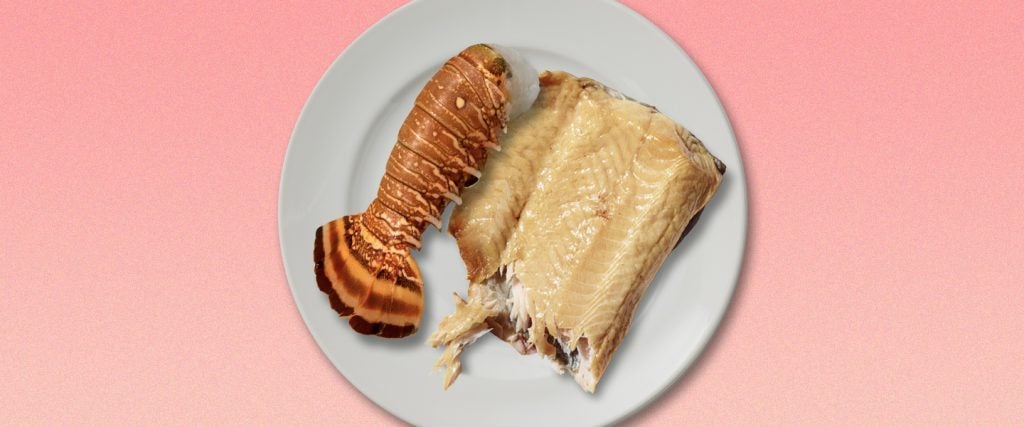After celebrating the end of a fishing trip in Nova Scotia with a massive seafood feast, Taylor Widrig found herself with tons of leftovers, including two huge lobsters and some salmon. Widrig, who won the 2020 Gourmand International Fish & Seafood Award, had no trouble repurposing her bounty into delectable meals. But for those of us who aren’t professional chefs and yet somehow end up with extra seafood we refuse to waste, what are we supposed to do with leftover salmon and lobster?
With limited time and resources, Widrig says she “decided to try a lobster bisque recipe that I’ve always wanted to perfect” after she brought her cache of leftover seafood home. Aside from the meat itself, lobster stock — which is made by boiling the shells with water, wine and aromatics — is great for a bisque, takes less than an hour to make, and is “packed with good nutrients like collagen.” After the bisque was made, Widrig “discarded most of the shells but saved some for the garden.”
Leftover lobster itself is fine to eat the next day, “so long as it’s properly kept in the fridge,” says Joe Bowab, founder of fresh lobster delivery service Lobster Anywhere. But after that, you run the risk of getting sick. As for his next-day leftover lobster go-to, Bowab contends that “the easiest leftover lobster recipe is lobster croissant sandwiches.”
“Light, flaky, and oh so buttery, lobster croissant sandwiches are simply heaven,” he says, adding that the pastries are “a perfect match for chunks of sweet, fresh Maine lobster meat.” The next best thing is lobster mac ‘n cheese. “Lobster goes well with just about any carb, but this has become one of New England’s most famed comfort foods,” Bowab continues. “The lobster, cheese and pasta combination is almost as beloved as the lobster roll sandwich.”
If making a lobster bisque, lobster mac ‘n cheese or a lobster croissant sandwich isn’t in the cards, your best chance at still getting the most mileage out of that expensive crustacean is getting it into the freezer. Unfortunately, though, you can’t just throw it in the freezer and call it a day — properly freezing lobster leftovers involves newspaper, vacuum-sealed bags and milk among other things.
Thus, it’s arguably easier to quickly repurpose your leftover lobster into a quiche or fish pie. Such is the reason Sylvia Fountaine, founder of the recipe website Feasting at Home, prefers to turn her leftover lobster and salmon into patties. “Personally, I think that leftover seafood is best when transformed — you won’t be getting the same unctuous texture as you did when it was first cooked, so why try?” she explains. “Salmon is a perfect leftover protein because it lends itself well to so many flavors, and salmon cakes whip up super quickly.”
Jim Mumford, purveyor of the healthy comfort food recipes at JimCooksFoodGood.com, concurs. “They sound fancy, but turning leftover salmon into salmon fritters is wildly easy,” he says. “Since salmon is high in fat, fritters stay wonderfully moist, even when recooked.” And since lobster is the “culinary cousin of crab,” Mumford says it’ll work as an easy substitute for your favorite crab cake recipe as well.
“These methods were invented to stretch out leftover bits of seafood, and are arguably better than the fish on its own,” he continues. “But if you want to finesse a bit on the presentation of your leftovers, take the leftover salmon skin and air fry it for three minutes, turning the skin into a salmon chip.”
Use that crispy salmon chip as a garnish, Mumford says, “and you’ll add a bit of salt, some height in presentation and $10 to your next plate.”

